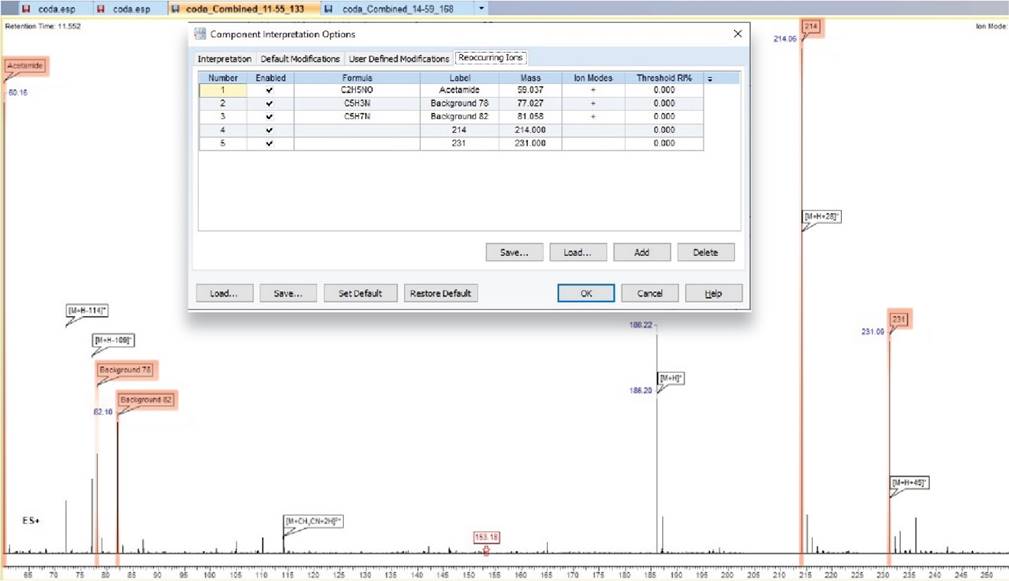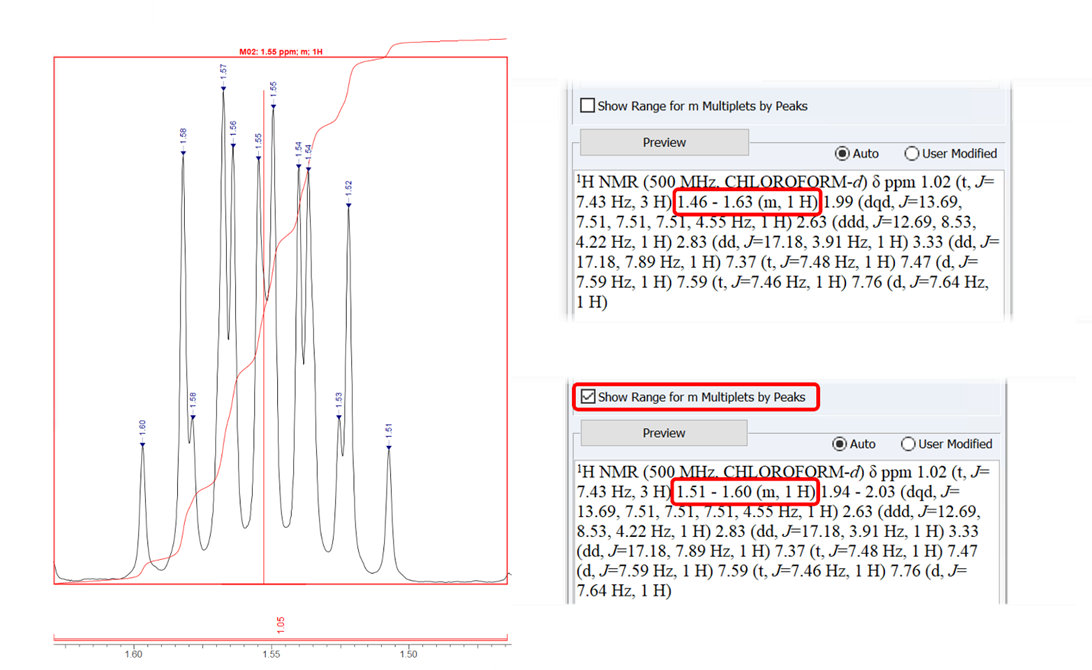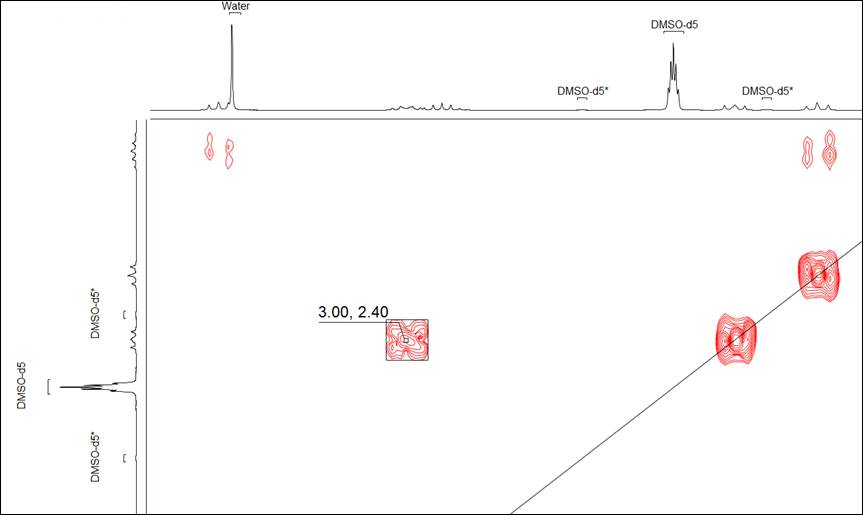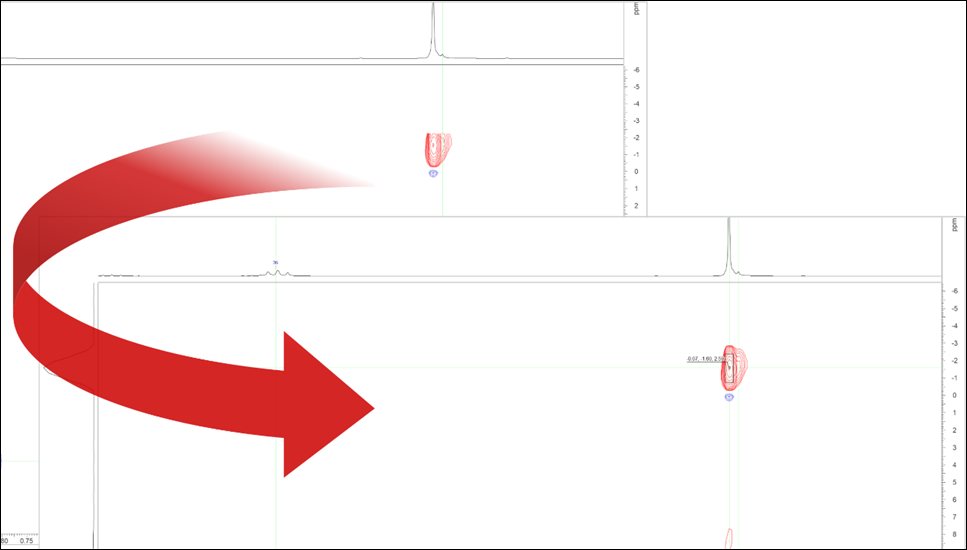Version 2024 of MetaSense improves several features, including a more exhaustive Table of Metabolites. Read below for details, and contact us for help upgrading your software.
Data Import
- You can now import data from the following formats:
- MS data from Bruker TIMS TOF (*.tsf)
- GC data from Shimadzu (*.gcd)
- We improved data import from:
- Standard BMRB bioNMR (*.seq and *.bmrb) biosequence structure and assignment data is now transferred to C-H correlation spectra (HSQC and HMQC), in addition to the previous N-H HSQC
Improved Analysis of Large Molecules through Multiply-Charged Ion Fragmentation
You can now use multiply-charged precursor ions in fragmentation analysis and optionally analyze multiply-charged product ions which often occur in the analysis of peptides and biomolecules.

Generation of multiply-charged fragments, indicated in the green box and highlighted on the MSn spectra.
Improved Display and Reporting of Structures on Chromatographic Traces
- You now have the option to selectively display structures on chromatographic traces, consolidating information in one place. This feature allows you to control which structures to display and include in reports.

Display selected structure(s) on chromatographic traces.
Simplified Analysis with Reoccurring Ions
- You can now add reoccurring ions to the Component Interpretation Options, allowing you to automatically search and label reoccurring ions when assigning a component

Highlighted ions are those populated in the reoccurring ions tab and are clearly labeled on the spectrum for ease of interpretation.
Greater Confidence in Identification with Improved MS Match Score
- You can now include multiply-charged ions and/or modifications into your MS Match score, giving you greater confidence in identification
Easier Analysis of Biomolecules and Peptides
You can now execute cleavage of disulfide and amide bonds with new fragmentation rules.
Improved Accuracy of Peak Areas
You can now perform peak fitting of hyphenated data.
- Extract more accurate peak areas and visualize results chromatographically and in tabular format
- Include both full and deconvoluted areas in reports
Process Extensive Lists of Targets More Quickly
IntelliTarget can now handle large lists of targets and process data up to 5 times faster.
Easier Review of Metabolites
Table of Metabolites now includes both Molecular Formula (MF) and Structure columns enabling facile review.

Molecular formula and structure columns for each metabolite can be viewed in the Table of Metabolites.
Improved Reporting Functionality
We have added more options for reporting functionality including:
- Ability to include full and deconvoluted areas in reports
- Ability to zoom to a defined region around an MSn Precursor
- Report “All” wavelengths for flat UV traces inside hyphenated datasets
- Display multiple descriptors on peaks in flat chromatograms such as retention time and name
Improvements in Quantitation
You now have access to new options for improving quantitation including:
- We now support Sciex data (*.wiff) file format in quantitation projects
- Calculate your unknown quantities more quickly with capabilities to:
- Populate concentration, volume, and mass columns when setting up your project by copying/pasting values (single cell, or columns) from Excel
- Move more quickly between cells with the use of keyboard prompts (i.e., the arrow keys, Enter or Space)
- Quantitate true analyte amounts by performing blank subtraction
- Standardize repeat measurements by normalizing data to internal standards
- Store data in a remote database to leverage knowledge across an organization
Improvements in Component Interpretation (IXCR)
You can now review more data in one place with options to:
- View Retention Indices (RI) from NIST MS Libraries in the Table of Components with your hits to aid in assigning confidence to the hit
- Optionally display a selection, or all the RI values
- View CAS Registry Numbers in the Table of Components from User Databases, providing a unique identifier
Improvements in the Use of Internal Standards in Hyphenated Data Sets (LC/UV/MS, GC/MS)
- You can now calculate relative areas for all components if one component is selected as the internal standard
Easier Export of Components to Excel
- You now have the option to selectively push results including structure and molecular formulae from the Table of Components to Excel
Improved Accuracy in Area Calculations
- Using improved peak picking for XICs you can now manually adjust the border and/or baseline of peaks on XIC traces
Improved Efficiency of MS Data Processing
- You can now use preset options for Profiles to link instruments to specific accuracy, reporting, preferences, and script settings
- Set known parameters by instrument to minimize errors and improve efficiency
Improved Visualization of MS and UV Spectra
- You can now more easily review data with fixed positions for UV and MS Spectra
- Component Spectra are permanently fixed on the left and scan spectra are on the right
Improved Regulatory Compliance
You can easily store and visualize XIC accuracies and identify the accuracy used to extract XICs.
- Optionally display accuracies in the LC/UV/MS legend, in the chromatogram legend, and appended to the chromatogram name
- Visualize any accuracy changes in the History Record
- Store and display XIC accuracy in Spectrus DB, and visualize in reports
Ease of Use Improvements
- Set Mass Accuracy for data processing in Da or ppm
- Quickly find metabolites of interest by sorting the Table of Metabolites by multiple columns by pressing “Shift + click”
- You can access all available options in mass spectral right-click menus at once
- Quickly restore your zoom with a new hotkey for zoom undo (“U”)
Improvements to Search Capabilities
Monoisotopic Mass Included in Table of Search Results by Default
- You can now automatically see the ‘Monoisotopic Mass’ column in the Table of Search Results
New Compensated Offset Spectrum Similarity Search Method for NMR
- You can now better search for spectra where the query and the hit have very similar multiplet structures, but the peaks are shifted by different amounts. This shift is often seen between spectra recorded at different pHs or temperatures, and can now be accounted for with the new Compensated Offset method of HQI calculation

New Approximate Mode for 2D NMR Spectral Search
- You can now search for 2D NMR spectra without exact peak matches with Approximate Mode
- Similar to 1D spectra, this search mode ignores the number of peaks existing in the search zones in the query and hits. The HQI is then defined by the ratio of corresponding search zones in the spectra.
Greater Flexibility in Selecting & Visualizing Queried Data
- You can now see select record information in Filter Tree view. Review filtered data and select the records of interest more quickly. (Previously you had to access individual records to view record information.)

- Choose the fields you want to be able to see in Filter Tree view (access via the screen forms editor)

- Choose the fields you want to be able to see in Filter Tree view (access via the screen forms editor)
- Dynamically visualize only your own records. Create a query to view records for the current logged in user.
Automatic Atom-by-Atom Mapping of Reaction Data for Comprehensive Query Results
You can now comprehensively search reactions or sub reactions for all relevant data. When you search a reaction or sub reaction, atom-mapping is automatically generated for the query and used in the search. (Choose to disable the atom-to-atom matching if/when you need.)
Improved Use of Web Links (URLs)
- Include weblinks (URLs) in tables

- Create a link for the current database record and copy it for use in other applications. (DB Read)
Example link: spectrusdb://%20/connect:localhost:7189,DB:%22Oracle%20DB%22,project:%22TEST%22%20/recid160284
Server-Side Improvements
- Performance optimization and improvements to the Web REST API
- Log management is better—choose to archive/delete log files, limit file sizes, and more
- You may now choose to deny connections to old versions of desktop clients
- TLS 1.2 protocol is now supported for https Web API calls
- A new command in the Enterprise Server Management Console (ESMC) Record Sets panel “Refresh Selected Record Sets (F5)” enables you to refresh the status of select record sets
- The PostgreSQL DB server and ODBC client have been updated to version 15.5-1
As always, you can process data from other analytical techniques in MetaSense. We’ve improved features for these techniques as well:
Processing NMR Data with MetaSense
Option to Define the 1H Range of Multiplets Based on Peaks
- You now have the option to report the chemical shift range of multiplets based on the outermost peaks in the Multiplet Report Options dialog box, in addition to the boundaries of integration
 Choose to report multiplet ranges according to the outermost peaks or the boundaries of the integration—either 1.51–1.60 (m, 1H) for the outermost peaks with the option checked (above), or 1.46–1.63 (m, 1H) according to integration boundary (below).
Choose to report multiplet ranges according to the outermost peaks or the boundaries of the integration—either 1.51–1.60 (m, 1H) for the outermost peaks with the option checked (above), or 1.46–1.63 (m, 1H) according to integration boundary (below).
Display Annotations of 1D Curves in 2D Spectra
- You now have the option to display the annotations of 1D curves in 2D NMR spectra

Show or hide the annotations of 1D curves in 2D NMR spectra.
Indication of Peaks Used for qNMR Calculation in Report
- You can now quickly identify which integrals are used in qNMR calculations with external standards in the Table of Integrals; which can now be included on the title page of the report
Option to Automatically Unfold HSQC Spectra for Structures with Si-CH3 Groups
- You now have the option to automatically unfold HSQC spectra along the F1 (13C) axis for structures with Si-CH3 This allows aliased peaks that are cut off to be picked properly.

Automatically unfold HSQC spectra along the F1 for structures with Si-CH3 groups.
Improved Features
New Integral Normalization Method for NMR Spectra
- You can now more accurately normalize 1H integrals of samples with various impurities with the Allow Excess option
- This can help prevent false negatives in workflows like Automated Structure Verification (ASV)

The Allow Excess option method for 1H integral normalization can avoid under-estimated integrals when impurities are present in the sample, which helps prevent false negative results in ASV.
- This can help prevent false negatives in workflows like Automated Structure Verification (ASV)
Perform External Standard Concentration Calculations Without a Sample Structure
- You now have the option to perform qNMR external concentration calculations in cases where the structure of the sample is not available. Do this by entering the molecular weight of the sample in the Concentration dialog box.
Improved Metrics for External Standard qNMR
- You can now calculate the relative sample purity by weight (w/w%) automatically with the Concentration Calculation tool
- You can now include the concentration calibration parameters in your report
Option to Show Only Unique J-Coupling Constants in the NMR Spectral Data Table
- You now have the option to show only unique coupling constants in the Spectral Data Table Advanced Options menu
- Instead of reporting a triplet as t(5.25, 5.25), it can now be reported as t(5.25)
Improved Reporting Functionality
- Ability to manually edit the NMR multiplet report text before copying to the clipboard or generating a report
Want to learn more?
Read more about the full features of MetaSense, or contact us for help upgrading your software.

